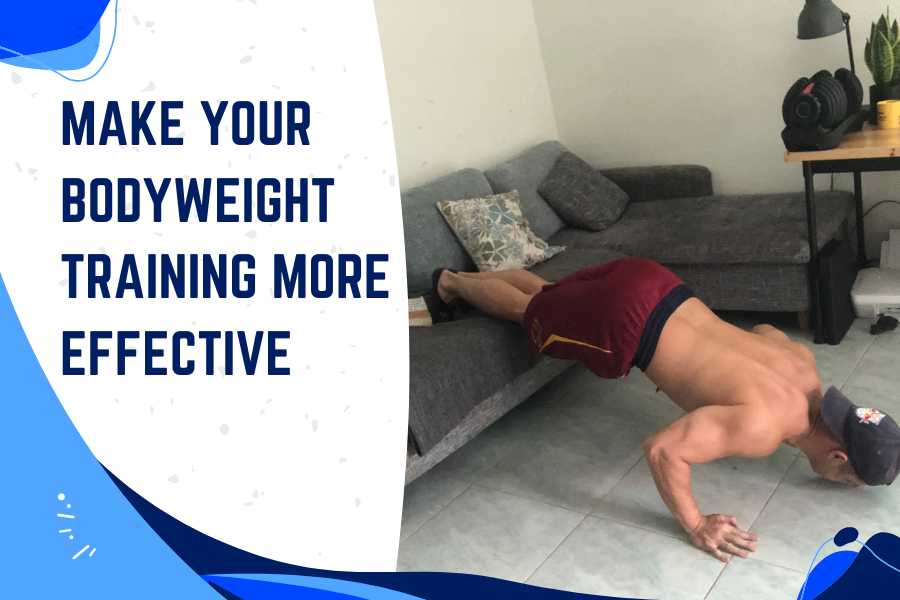Bodyweight exercises such as squats, push-ups, and pull-ups are effective for building muscle and strength. But it’s important to keep your training challenging to make continued muscle and strength gains. So how do you make calisthenics exercises harder when you’re limited by your own bodyweight?
Increasing set duration is the easiest way to make bodyweight exercises more difficult. This can be achieved by prolonging the duration of each rep through methods like temp reps, isometric holds, pulsed reps, and 21s. External weight can also be added to increase intensity.
Belowm, I share 14 unique ways to overload your muscles and keep your bodyweight training at a high enough intensity to gain muscle fast.

Why Make Bodyweight Exercises Harder?
It is essential to make bodyweight exercises harder to sustain muscle and strength gains. Increasing exercise intensity, through modifications or the addition of weights, forces the target muscles to adapt by getting bigger and stronger.
This is called progressive overload. It is a key training principle for anyone looking to achieve a buff transformation.
By overloading your muscles, you increase the intensity of the 3 stimuli that drive muscle gains:
- Mechanical tension: this refers to the amount of weight loaded onto a muscle. The heavier the weight the greater the exercise intensity and the greater the muscle growth stimulus.
- Time under tension: this refers to the duration a muscle remains contracted. The longer the TUT the greater the metabolic stress and muscle growth stimulus.
- Metabolic stress: this is the burning sensation you feel in your muscle after an intense set. It results from increased blood flow and the accumulation of metabolic waste products like lactic acid.
By increasing the intensity of these 3 stimuli, you increase muscle fiber recruitment, activation, and damage. And this is important for getting bigger and stronger.
Looking to transform your body? You can check out my other post to find out how long it takes!
11 Ways To Make Bodyweight Exercises Harder Without Adding Weight
Bodyweight training can be made more challenging and effective without adding external weights. These methods usually revolve around varying the tempo, speed, and angle of each exercise repetition.
These methods alone were sufficient for me to build muscle at home with bodyweight workouts
1) TUT tempo reps
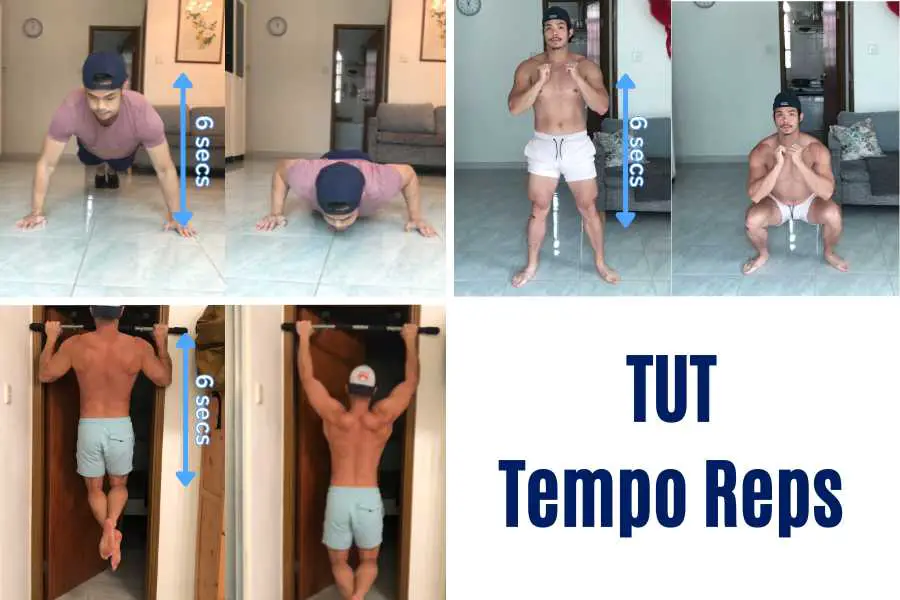
By purposefully extending the tempo of your bodyweight exercises and performing them slowly, your muscles have to work harder to control the movement.
In a push-up example, slowly lower your chest towards the ground to a count of 3 seconds. Now press yourself back up to another 3 seconds.
Studies have indicated that TUT is a great way to target your type II slow-twitch muscle fibers which can often be neglected in traditional strength training movements.
2) Explosive reps
Explosive reps (also called plyometric reps) require maximal force exertion in the shortest amount of time, increasing the intensity of bodyweight exercises and making them harder to perform.
In a bodyweight squat example, exert maximum pushing power to drive yourself back up once you’ve reached the bottom position. I like to explode into a jump squat to really work my legs.
This 2012 review indicates that explosive training like this is a great way to target your type II fast-twitch muscle fibers. These muscle fibers are also the most responsive to hypertrophy.
3) Isometric holds
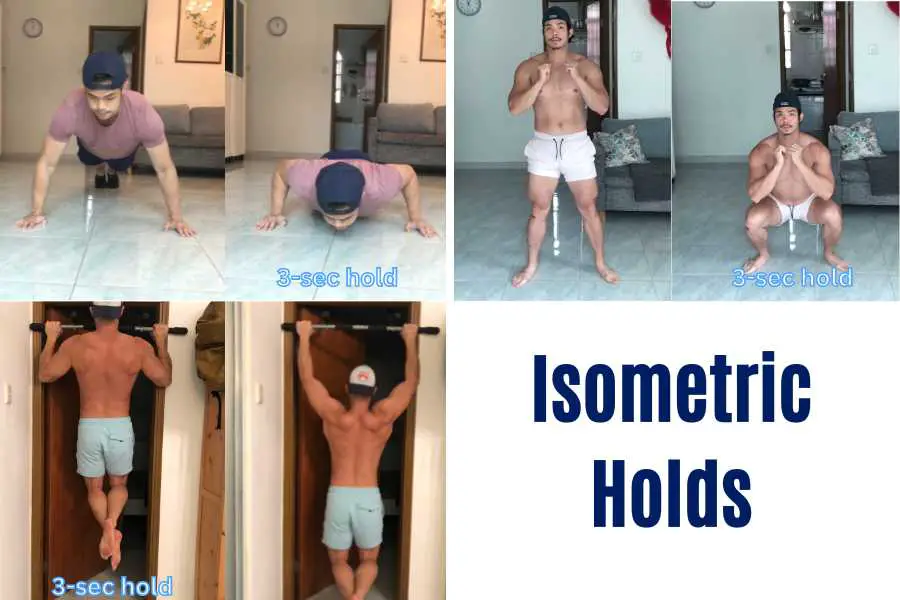
Isometric reps incorporate a static element in your bodyweight training, increasing the intensity and challenge.
Instead of performing normal reps of an exercise, isometric holds require you to hold a position or posture in a specific part of the range of motion.
This prolongs muscle activation and challenges your muscles in a completely different kind of way compared to normal reps.
The plank is a classic isometric exercise. But the same principles can be applied to any bodyweight movement.
In a pull-up example, pull yourself to the top point and hold this position for 3 seconds before resuming the exercise. In a squat example, pause for 3 seconds at the bottom of the squat.
4) Pulsed reps
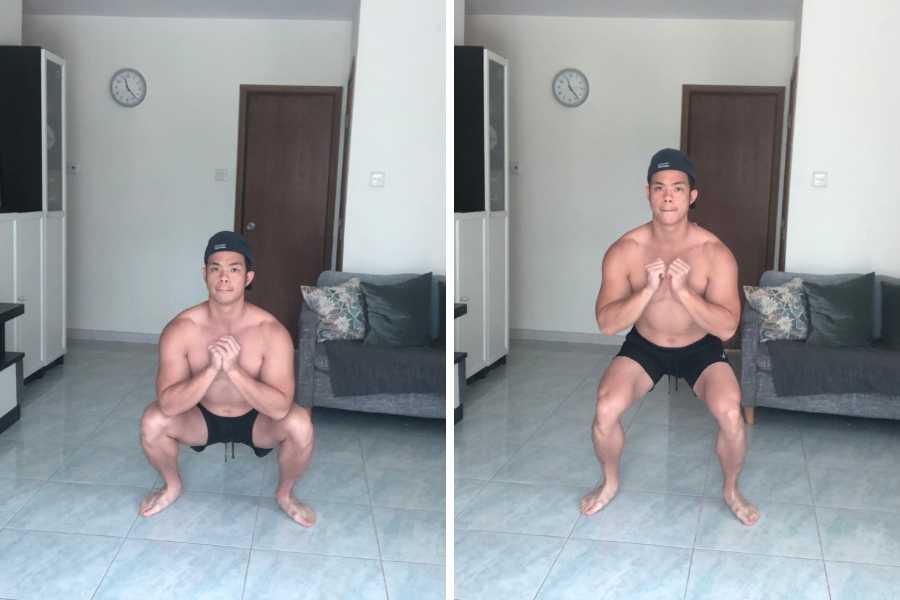
Pulse reps are partial reps performed rapidly and consecutively within a specified part of an exercise.
This makes your bodyweight exercise harder by sustaining TUT and metabolic stress in specific areas within the full range of motion (ROM).
The principle behind pulse reps is based on the fact that different muscle regions are responsible for different parts of a movement. Pulse reps are therefore ideal for emphasizing different muscle regions.
In a squat example, pulse reps can be completed in the bottom half of the ROM. This part of the ROM is quad-dominant, allowing you to target the quadriceps.
5) Brace the core
Core bracing involves engaging the core (abs) during a bodyweight exercise to make it harder and more effective.
You can do this by actively contracting your core muscles throughout the entire exercise duration. The harder you contract, the greater the muscle activation, and the better the results.
Not only does this simple training method make a bodyweight exercise more challenging, but it can also be useful for burning fat and getting ripped abs.
To get a shredded core, it’s also recommended to train the abs with additional sets of isolation exercises like crunches and sit-ups that directly target the abdominal muscles.
Important note: building muscle requires you to go on a bulk. If done incorrectly, this can cause you to lose ab definition. You can check out my other post for tips on how to keep your abs when bulking.
6) Rest-pause training
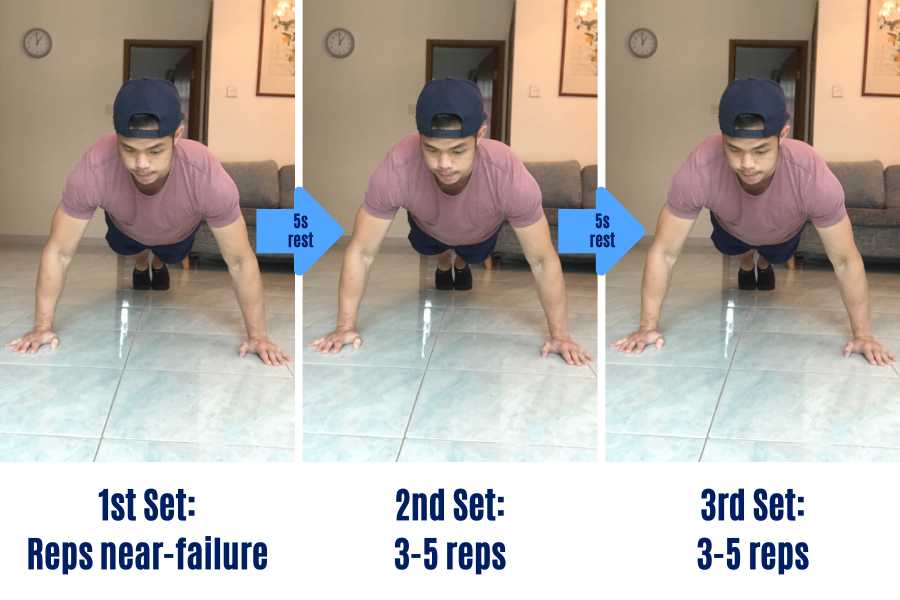
Rest pauses are 3-10 seconds intervals of rest taken toward the end of a set when a muscular burn and metabolic fatigue start to kick in.
The brief rest allows you to extend a set beyond the point of muscular failure, allowing you to increase volume, and make the bodyweight exercise more difficult and effective.
In a push-up example, complete as many reps as required to reach muscular failure on your first set. Now take a 5-second rest and perform another 3-5 reps before you’ve had a chance to fully recover. Take another 5-second rest and perform another 3-5 reps.
Rest pause training is also a quick and efficient way to keep working in the “burn zone” which is great for building muscle.
7) Unilateral variations
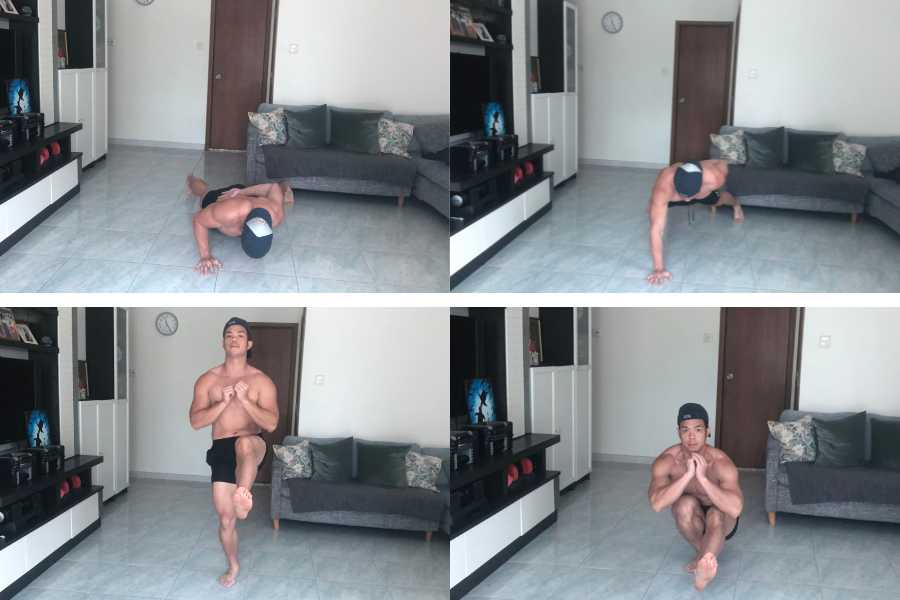
Unilateral bodyweight movements are performed on one limb at a time, making them much more challenging compared to their bilateral (two-limbed) variations.
By using only one limb, you’re effectively doubling the weight and putting greater mechanical tension on the target muscle.
Unilateral movements are also great for correcting muscle imbalances and working the stabilizers.
Classic examples include one-handed push-ups and pistol squats.
8) Decrease rest duration
Decreasing the time you rest between sets can increase metabolic stress in your muscles and make bodyweight exercises much harder.
As seen in this 2018 study, by sticking to resting times of 30-60 seconds between sets, you get an accumulation of metabolic waste products that lead to the “lactic burn” sensation.
This forces your muscles to make cellular adaptations that are similar to that seen from HIIT training.
And as a result of these adaptations, your muscles grow bigger and stronger. You can also expect your cardiovascular fitness to improve.
If you’re a beginner, you can start with 60-second rest durations between sets and gradually reduce by 10 seconds each week until you’re resting for 30-seconds between sets.
9) Supersets
Supersets involve performing two exercises back to back with no rest in between.
The reason it makes your bodyweight workouts more difficult is that you force your muscles to remain under tension for longer durations in the “burn zone” where metabolic waste products accumulate.
As a result, your muscles make the cellular adaptations described in the previous point (“#8 decrease rest duration”).
Supersets can be done with any combination of bodyweight exercises.
But for best results, I recommend beginners to superset movements that target different muscle groups, for example, push-ups and squats.
10) Vary the angle
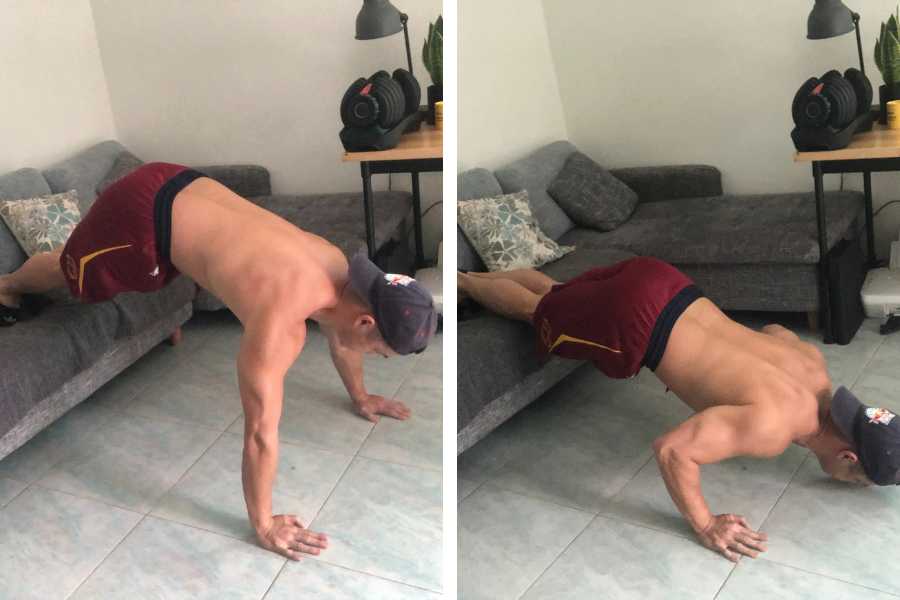
This tip applies to push-ups, which are a great way to build a bigger chest using your body weight.
By adjusting the angle of the traditional flat push-up, you can emphasize the specific parts of the pectorals (a muscle that spans the entire chest).
This is important because, whilst flat push-ups hit all pectoral regions to a degree, you need to emphasize the upper and lower pecs with angles for best results.
For example, you can prop your feet on a couch to do decline push-ups and emphasize the upper pecs and shoulders. You can also do incline push-ups by placing your hands on a tabletop or bar to emphasize the lower pecs.
By changing the angle of the push-up, you gain better leverage to target the upper and lower chest, and this can make the push-up harder to perform, especially if you rarely do angled variations.
11) Use 21s
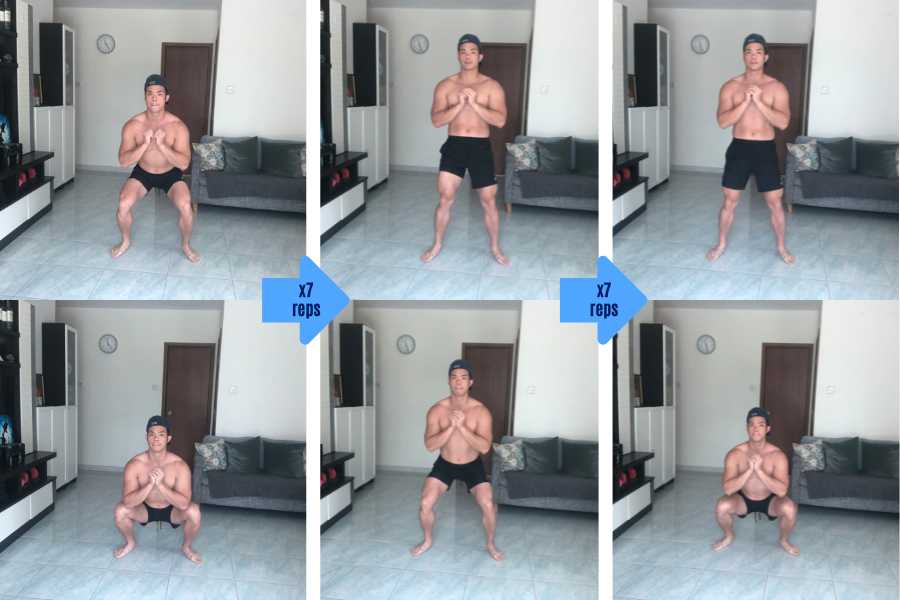
21s is a training method that can make any bodyweight exercises harder and more effective for building muscle, strength, and endurance.
It involves performing an exercise for 3 consecutive sets of 7 reps. Each set focuses on a specified part of the range of motion.
In a squat example, you could do 7 reps in the bottom half of the movement (targeting the quads), then 7 reps in the upper half of the movement (targeting the hamstrings), before finishing with 7 reps of squats completed to a full range of motion (targeting the whole leg).
This is a great way to increase overall volume, TUT, and metabolic stress in the target muscle.
3 Ways To Make Bodyweight Exercises Harder With External Weights
Don’t mind investing in cheap but effective home gym equipment?
Bodyweight training can be made more challenging and effective by adding external weights. Popular examples include resistance bands, dumbbells, kettlebells, and weighted vests.
These are cost-effective ways to increase the intensity of bodyweight workouts and build maximum muscle and strength.
12) Resistance bands
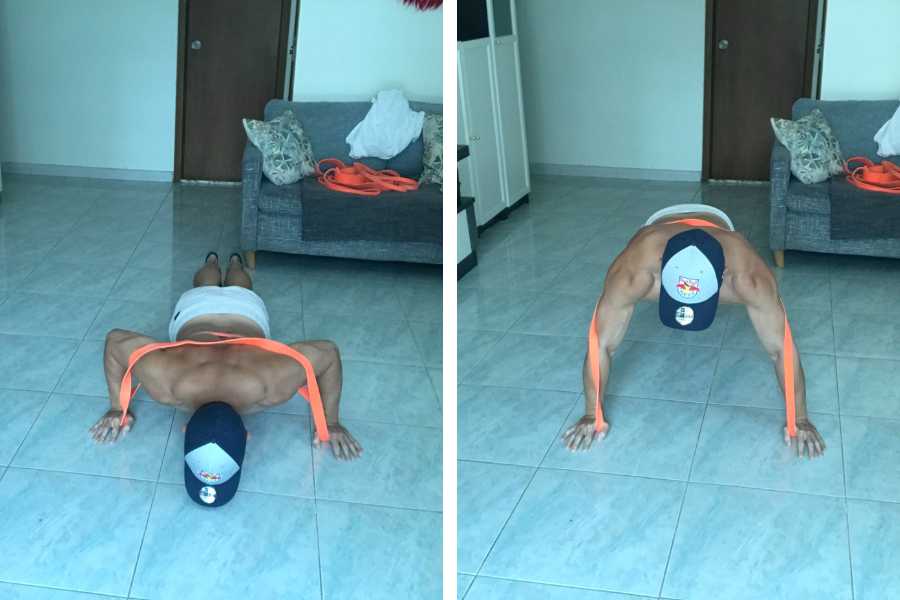
Resistance bands have many benefits that make them ideal to take your bodyweight workouts to a completely different level.
Other than cost-effectiveness and convenience, bands have a unique property called linear variable resistance, meaning tension progressively increases as the band stretches.
This is a great way to increase the challenge in the top half of the range of motion in bodyweight exercises.
In a push-up example, you can wrap a band around your back and anchor them to the floor using your hands. As you press yourself, up you’ll feel the push-up gets much harder (where normally it gets easier towards the top).
I use and recommend the Undersun band set (my review) for its durability and great value for money. They can also be used for pull-up assistance.
13) Free weights
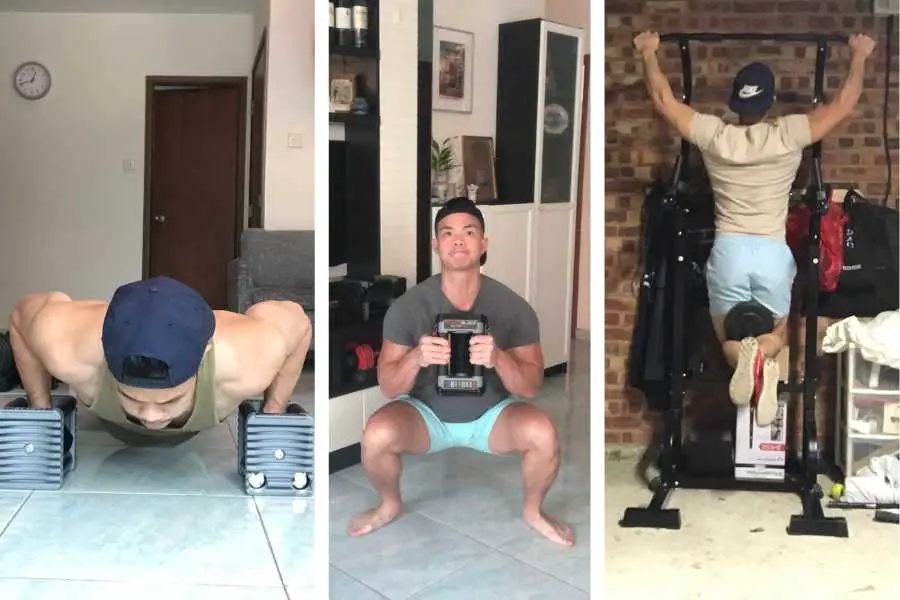
Free weights like dumbbells and kettlebells are affordable, convenient for home use, and are great for beginners to build muscle.
By holding a weight in your hands, you add resistance to your bodyweight exercises, increase mechanical tension, and make them more challenging.
I love including weights in bodyweight HIIT workouts to build muscle, gain strength, and get ripped.
Free weights can be used to add weight to any bodyweight movement. They can also be used to increase the range of motion in the push-up for a greater pectoral stretch and activation.
14) Weighted vest
These serve the same purpose as free weights. The only difference is that the weight is strapped to your body instead of being held in your hands.
This makes them more suitable to add resistance to the push-ups in particular, where your hand’s aren’t available to hold weights when they’re being used to support your body.
A weighted vest is also great for adding weight to pull-ups, squats, and any other bodyweight movement.
They come in various loads, from as little as 5kg to as much as 20kg.
Example Progressions To Make Bodyweight Training Harder
With so many different methods to make your bodyweight exercises more challenging, how do you incorporate them into a routine? How do you progress?
Here are 3 example progression plans for beginners to build strength and muscle from push-ups, squats, and pull-ups.
Push-up progression plan:
| Week | Bodyweight Exercise | Sets | Reps |
|---|---|---|---|
| 1 + 2 | Standard flat push-ups | 4 | 15 |
| 3 | Explosive push-ups | 4 | 12 |
| 4 | TUT tempo push-ups | 4 | 7 |
The standard flat push-up is a great all-around chest builder.
After you’ve been accustomed, transition to explosive push-ups and reduce reps. These will train your power and strength.
Next, move onto tempo push-ups and reduce reps further. These are great for increasing TUT, metabolic stress, and endurance. When they’re done properly, you should feel a massive muscle pump in your chest and arms!
Bodyweight squat progression plan:
| Week | Bodyweight Exercise | Sets | Reps |
|---|---|---|---|
| 1 | Standard bodyweight squat | 5 | 20 |
| 2 | Isometric hold bodyweight squats | 4 | 12 |
| 3 | Squat 21s | 4 | 21 |
| 4 | Single-leg pistol squat | 4 | 4 |
Use bodyweight squats to familiarize yourself with the movement pattern.
Reduce reps and introduce a 3-second pause at the bottom of each squat and hold this position before driving back up. This increases TUT and metabolic stress.
Use squat 21s to increase TUT and metabolic stress in different parts of the range of motion. This is great for emphasizing the quads and hamstrings.
When you’re ready, attempt pistol squats. These are difficult. Aim for 4 reps to start, and build from there.
Pull-up progression plan:
| Week | Bodyweight Exercise | Sets | Reps |
|---|---|---|---|
| 1 + 2 | Band-assisted pull-ups | 4 | 12 |
| 3 + 4 | Unassisted bodyweight pull-ups | 4 | 8 |
| 5 + 6 | Dumbbell-weighted pull-ups | 4 | 6 |
| 7 | Isometric hold bodyweight pull-ups | 4 | 6 |
| 8 | TUT tempo bodyweight pull-ups | 4 | 5 |
This is a longer progression plan than the previous 2 because most people need more time to develop pull-up strength compared to other bodyweight exercises.
Start your pull-up plan using band assistance. Move onto progressively lighter bands as fast as possible until you’re on the lightest band.
Once you’re able to do 12 reps using a light band, you should be able to do 8 unassisted reps.
Next, add a 5-10lb dumbbell (hold it between your legs).
After that, you can revert back to bodyweight pull-ups but introduce a 3-second hold halfway into the rep.
Finally, you can try tempo reps by prolonging each rep to 6 seconds (3-sec up and down) to increase TUT and metabolic stress.
Conclusion
You can make bodyweight exercises harder and more effective by modifying your reps. These modifications often revolve around prolonging each rep with pauses, holds, and pulses.
Inter-set rest duration can be decreased and the rep number can also be increased for an extra challenge.
Additionally, external weight can be added through bands, dumbbells, kettlebells, and vests.
The overall aim of increasing bodyweight training intensity is to increase mechanical tension, TUT, and metabolic stress in your muscles. These 3 stimuli drive muscle hypertrophy and strength gains.
You may also be interested in the downloadable Kalibre Blueprint PDF which details exactly how I gained 40lbs of lean muscle (it’s 100% free!). It details the exact exercises and nutrition (with printables) I used to go from skinny to ripped!

